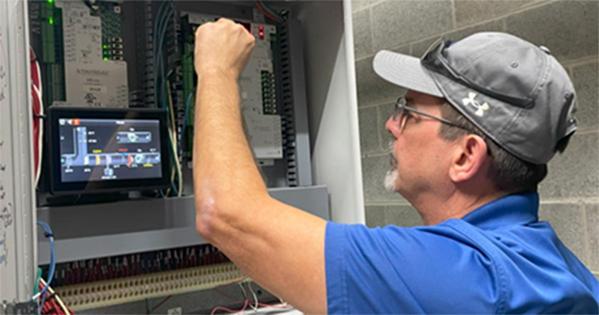Building Automation Systems – a ‘Sixth Sense’ for Ensuring Energy Conservation and Optimal Efficiency

With ten LEED-certified buildings on campus already and the Meltzer Center – American University’s first net-zero building – under construction, how do university engineers ensure that energy conservation and optimal efficiency are maintained in campus buildings?
The answer lies in the team’s utilization of the building automation systems (BAS), a series of sensors, actuators, and computers that allow them to monitor and control, in real time, the mechanical, electrical, and security systems in the buildings. The BAS achieves energy conservation and efficiency by monitoring and controlling the mechanical systems that support space heating and cooling.
So how does the BAS affect the room you are in? Chances are, there is a thermostat in the room that controls the space’s temperature and air flow. What is not readily apparent is that the thermostat sends information such as room temperature, room occupancy, heating, or cooling needs back to a central computer. That information, from all the thermostats, helps determine what the campus needs to be comfortable. The data determines what major system heating and cooling equipment needs to be running. The campus BAS monitors and assures that those functions are working optimally.
“In a way, the BAS almost gives us a ‘sixth sense’ for maintaining the comfort level on campus," said Hung Nguyen, BAS programmer.
The BAS allows for scheduling the start/stop of major pieces of equipment such as building air conditioning systems and monitors various setpoints and provides adjustments of space temperatures. Enhanced systems fault detection analysis and data trending are some of the other capabilities of the system. Systems faults are detected in real-time, and communicated to facilities managers via email, with text notification as an additional option. This new enhancement supports quicker response times for issues.
The Facilities Management Building Automation Team is responsible for operating and maintaining the university’s BAS. The system covers fifty buildings and consists of 149,175 data points. In fact, two building automation systems – Automated Logic and Siemens – are used for this purpose. The Automated Logic system was brought on-line in 2019 and in early 2024 the Siemens system was upgraded to the new web-based Desigo platform. These new platforms provide remote web access, improved graphics, and enhanced system alert capabilities.
Data trends of temperature, water, and electricity usage are collected for internal analysis and are externally processed through an energy management reporting system that turns the raw data into actionable information to help identify facilities or systems that may require corrective actions, or that may be candidates for efficiency improvement projects.
"The ability to monitor energy usage on a constant and consistent basis is the key to unlocking energy savings and efficiency in every building," said Dennis Smith, building automation technician.

SIS main air handling unit, AHU-1 (Siemens Desigo)
An example of the actionable information produced by the energy management reporting system is the heatmap used to track energy and usage performance during the annual winter break energy curtailment efforts. The information gathered is also shared annually with staff, students, and faculty to help support our campus’ conservation goals.
“The integration of AU’s BAS transforms campus buildings into a smarter, more efficient, and more sustainable environment, enhancing the quality of life for its occupants as well as reducing the university’s energy costs,” Eddy Peng, Building Automation Supervisor.
